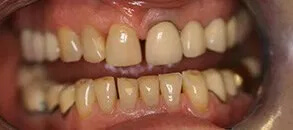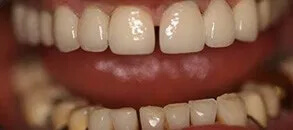What are Dental Veneers?
A dental veneer is a thin layer of material placed over a tooth, either to improve the cosmetic appearance of a tooth or to protect its surface from damage. There are two main types of material used to make a veneer: composite resin or dental porcelain.
A composite resin veneer is typically built up directly in the mouth, whereas porcelain veneers are manufactured by a dental technician. In order to do this, a dentist must first take an impression of your teeth. This is then sent off to the technician’s laboratory to manufacture the veneer(s). The impression allows for the veneer(s) to perfectly fit your teeth. The dentist then cements this newly crafted porcelain veneer onto the teeth.

TEETH BEFORE VENEERS

TEETH AFTER A COSMETIC TREATMENT USING CROWNS AND VENEERS
Who needs Dental Veneers?
Dental veneers are an essential tool in cosmetic dentistry. A cosmetic dentist may use one veneer to restore a tooth that has been fractured or discoloured or multiple teeth to create a total smile makeover. Some people have small teeth with wide gaps that are not quickly closed by orthodontics. Porcelain veneers can solve this problem by increasing the perceived size of the teeth, thereby making the teeth appear more prominent and the gaps between them smaller. This can have the same cosmetic effect as orthodontics and is achieved in a fraction of the time.
Some people have worn away the edges of their teeth, resulting in a prematurely aged appearance, while others may have poorly positioned teeth that appear crooked. Multiple veneers can lengthen teeth that have been shortened by wear, fill the black triangles between teeth caused by gum recession, provide a uniform colour, shape, and symmetry, and make the teeth appear straight. Dentists sometimes also recommend using thin porcelain veneers to strengthen worn teeth. Thin veneers are a practical option for ageing patients with worn dentition. Minimal or no tooth preparation is often needed when using porcelain veneers.
Each situation is different, and the dentist should assess what is best for each case. Veneers are, in reality, partial crowns; in some situations, a fair amount of tooth structure must be removed to get the ideal result. A combination of orthodontics (dental braces), whitening (bleaching) and bonding composite resin can get a great result without veneers.
What happens when I get veneers at 92 Dental?
- Getting veneers at 92 Dental is usually a straightforward process. The stages can vary, however, depending on whether you are getting porcelain or composite veneers and how much restructuring of the tooth or teeth is needed before veneers are placed.
- As with all our treatments, getting veneers will begin with a consultation with one of our cosmetic dentists. During this consultation, we will examine the current state of your teeth, go over exactly how you want your teeth to finally look, and evaluate whether veneers offer you the best option to get the desired outcome. All stages of treatment and their costs will be discussed during this consultation.
- Once it has been decided that veneers are the best cosmetic treatment for you, getting them made and fitted usually takes three sessions with the cosmetic dentist.
- The first of these is called the diagnostic wax-up. This usually takes about 30 minutes and involves planning in detail what the final veneered teeth will look like. We take shade to determine what the final colour of the veneer will be. This can be a whiter shade than your current tooth but will be a colour that matches your other teeth to give a natural-looking finish. We will also determine whether we need to prepare your teeth in any way for the veneer to be attached.
- Soon after the diagnostic wax-up, a second session will be booked where we will take impressions of your teeth to send to the technician. This session will also include any preparatory work we may need to do to the teeth for the veneer to be attached. Such initial work may consist of filing down the tooth structure or reshaping the tooth. Depending on how much preparatory work is needed and how many teeth are being veneered, this session can take one to two hours.
- After about two weeks, the time needed for the dental technician to create the veneers will be fitted onto the teeth. The cosmetic dentist will use a specialized dental cement to attach the veneers to the teeth. This is the final stage of treatment, and your smile will be fully restored once the veneers have been linked to your teeth.
- Please note that this describes the patient’s journey to getting porcelain veneers. Composite veneers, which we use less frequently, take much less time as they are created in the mouth by the dentist. They can typically be made in one session following a consultation.
Book a Consultation

Gavin Mack
GDC No. 74406
BDS, MSc, MOrth, FDS (Orth) RCS Eng.
BDS (Honours) – University of Newcastle Upon Tyne
MSc (Distinction) – University of London
MOrth and FDS (Orth) – The Royal College of Surgeons, England
- 22 years experience in Orthodontics
- Treated and supervised over 3,000 complex orthodontic cases
- Specialist orthodontist and consultant in a teaching hospital
0% FINANCE IS AVAILABLE FOR MANY TREATMENTS
Applying only takes 2 minutes, and you’ll get your answer immediately.
Find out more about our practice

Established since 1932
Long established Hammersmith dental practice

specialist team
Multi-specialist team and advanced digital technology

referral centre
Referral centre for other practices

0% finance
Flexible payment options, including 0% finance

accessible
Accessible facilities and hearing loops
